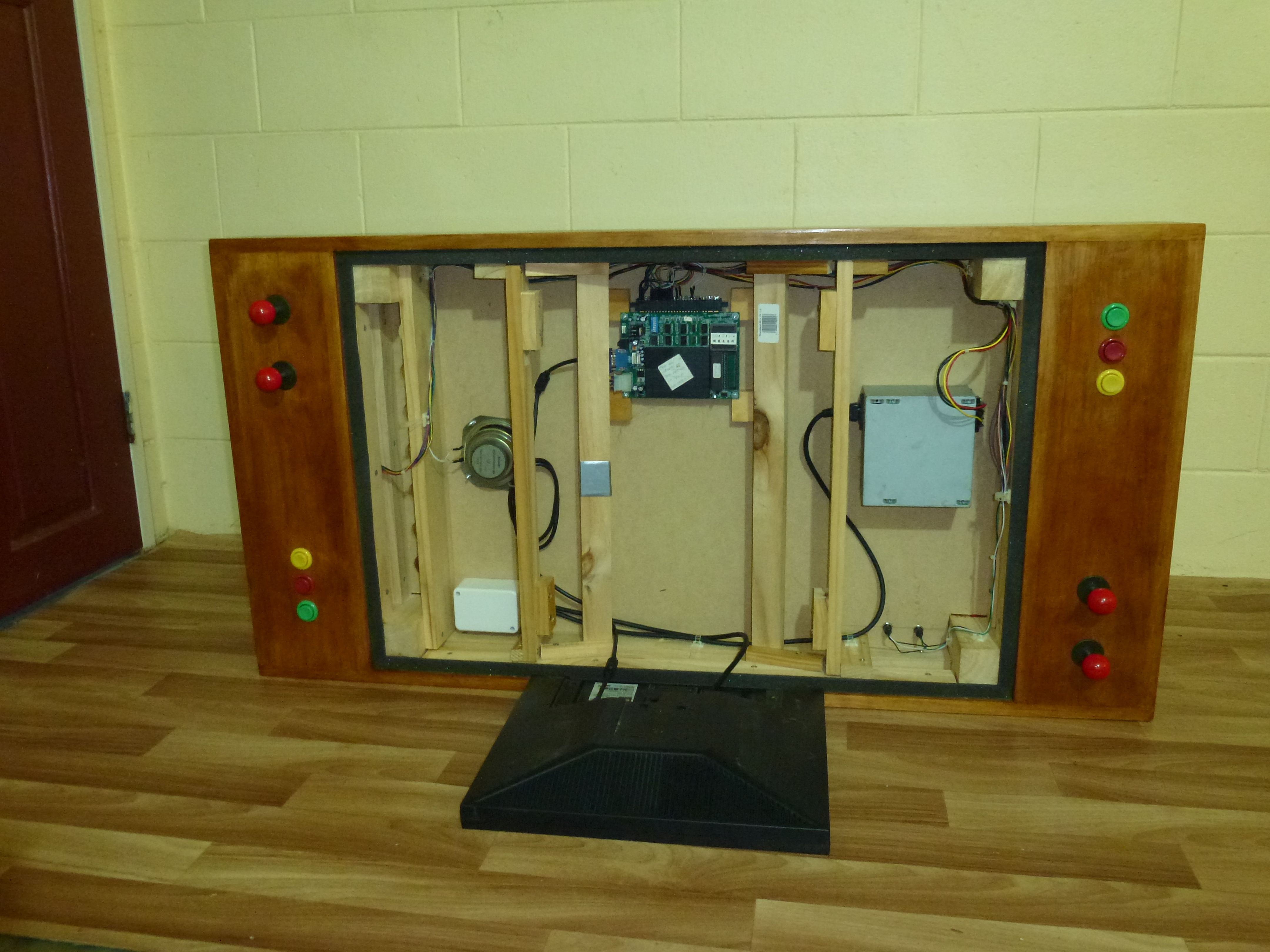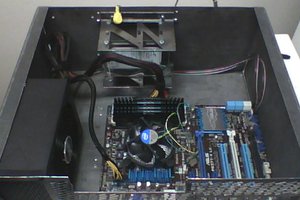The finished table.
(The cat is for scale, I didn't have any bananas)
Probably the first thing you notice is that there are two joysticks on each side.
Some older and cherished games like Pacman came out with a 4-way joystick and the code was never written to deal with the extra combinations of an 8-way joystick. Consequently they are unplayable with an 8-way joystick.
My first attempt at solving this problem was to put something ending in 'duino' between the joystick and the game board. It was to use an 8-way joystick but be switch selectable into a 4-way mode where it would prevent the switch combinations that 4-way games don't work with.
The code went well and did exactly as I expected and the the 4-way games worked with it well. It's failing was that it didn't have the haptic feedback of an actual 4-way joystick and made game play a little less concise.
Here is the table, on it's side with the top removed.

And here with the 19 inch monitor removed.

There is a foam seal around the edges where the glass sits to prevent spilt drinks from getting into the machine.
Here is the bottom.

Air drawn in by the power supply (a modified PC PSU) and is exhausted through the series of holes towards the bottom. This is mostly for the monitor as the other components generate very little heat.
This is a view of one end control section from the bottom.

Square finger-join wood is used throughout the inside of the machine so that the screws screw from the inside pointing out. That way no screws are visible from the outside except for the bottom panels where access may be needed for repair at some time.
Power enters from the bottom here.

The top side is protected by a junction box (jbox) cover so that there are no exposed high voltages.

The jbox cover removed.

These are simply IEC cords. One plugs into the monitor and the other plugs into the power supply.
The power supply is just a modified PC power supply.

There were two basic modifications. One was to ground the power on wire so that it turns on as soon as power is supplied. The other was to connect the 3.3 Volt sense wire to 3.3 Volts internally so that the only external connections are 5 Volts and 12 Volts.
The game board is an iCade 60 in one. These work well and generate very little heat. They don't require a fan and have no high density connectors to get choked up with dust so I expect it will be far more reliable than a PC based game platform like MAME.

It is also a standard JAMMA card so it can be swapped with other game cards.
The vents are made in such a way that the hotter air from closest the glass is exhausted first.

The wiring harness is clipped into place with tie blocks and zip ties.

I used a car audio speaker. It turned out to have a little bit too much base. A cheep lo-fi speaker would have been better.


The controls all use quick-disconnect terminals that have been soldered and insulated with heat shrink. The heat shrink is more to absorb vibration to extend the life of the connection. These Joysticks are both the same. The green plastic is placed into different positions for 4-way and 8-way use.

Here are the 3 buttons. Only one game uses the third button and it is playable without it. In hindsight I should have left it out and perhaps disabled that one game.

If I were to do this again I would do some things differently. Throughout the machine there are two rows of finger join. One for the bottom panels and one for to support the glass. I should have lust used a small plank of the right width as it would have saved a lot of effort.
The best starting point is make a stand or platform for the VESA mount of the monitor and then choose some small planks that are the width of the height of the monitor on top of the platform. You could complete the inside of the unit with these small planks and then more or less veneer the outside wood onto that, screwing from the inside. This would be far less effort.
 Hacker404
Hacker404



 Jake
Jake
 Greg Does Things
Greg Does Things
 Keith
Keith
 Kayser-Sosa
Kayser-Sosa
http://www.ultimarc.com/servostik.html
maybe this would solve the 4-8 way problem?